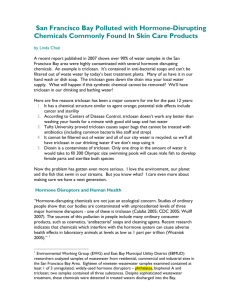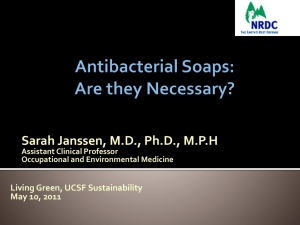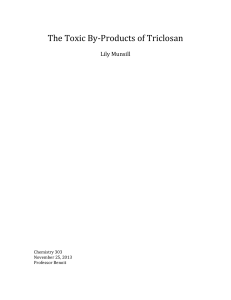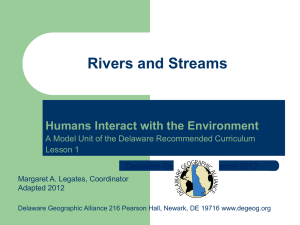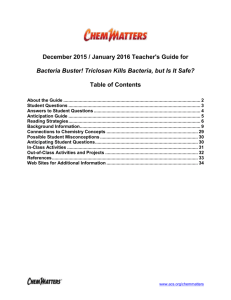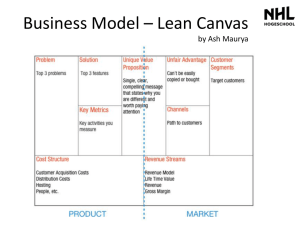Escherichia coli - Illinois Sustainable Technology Center
advertisement
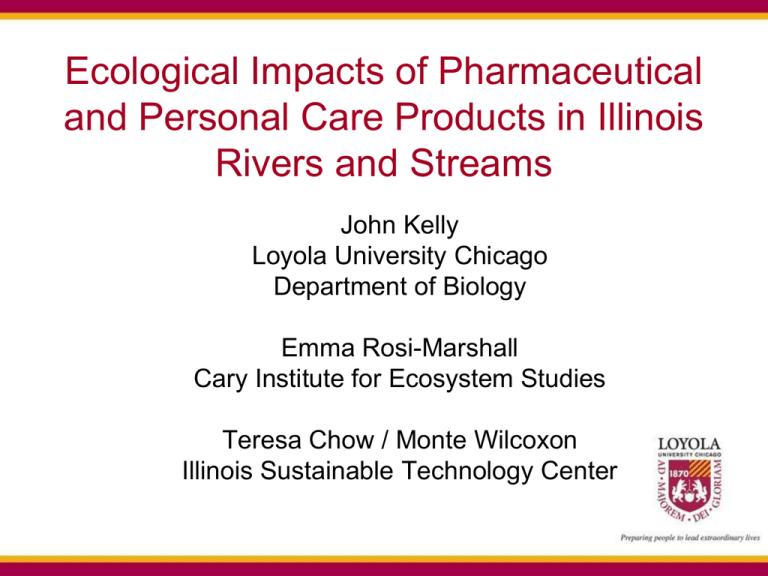
Ecological Impacts of Pharmaceutical and Personal Care Products in Illinois Rivers and Streams John Kelly Loyola University Chicago Department of Biology Emma Rosi-Marshall Cary Institute for Ecosystem Studies Teresa Chow / Monte Wilcoxon Illinois Sustainable Technology Center Pharmaceutical and Personal Care Products (PPCPs) • Prescription and non-prescription drugs: • • • • • • Antibiotics Analgesics Antihistamines Antacids Hormones Caffeine • Household Products • Antibacterials / Antimicrobials Release of PPCPs to Environment • Domestic wastewater – PPCPs have been detected in domestic wastewater • Wastewater treatment plants – Remove most PPCPs well • Removal of PPCPs is generally not 100% • Low level PPCP release to surface waters via effluent – Some PPCPs partition to biosolids • Land application of biosolids can release PPCPs due to leaching PPCPs have been detected in U.S. rivers and streams • Kolpin et al. 2002 (USGS) – Suite of 95 contaminants – Surveyed 139 streams in 30 states • Biased toward streams susceptible to contamination • Analyzed water only – Found 82 of the 95 contaminants – Contaminants in 80% of streams – Concentrations were generally low • 95% of the concentrations measured were below 1 mg/L Ecological effects of most PPCPs are unknown • PPCPs are biologically active • PPCPs are likely to have ecological effects: • Classes of organisms • Acute vs. Chronic effects • Community composition • Ecosystem processes Triclosan • • • • 5-chloro-2-(2,4-dichlorophenoxy) phenol Potent antibacterial compound Discovered in 1960s Mode of action – Blocks synthesis of lipids in bacteria – Inhibits enoyl-acyl carrier protein reductase • Used primarily in hospitals as an antiseptic and disinfectant Triclosan • Between 1992 and 1999 700 products containing triclosan entered the consumer market in the US • Currently found in: – Soap – Detergents – Cleaning Products – Toothpaste / Mouthwash – Paint • Has been embedded in – Plastics – Textiles Triclosan has been detected in U.S. rivers and streams • Kolpin et al. 2002 (USGS) – The most frequently detected compounds were: • Diethyltoluamide (insect repellant) • Caffeine • Triclosan (58% of streams) • Trichloroethylphosphate (fire retardant) – Concentrations in water were generally low • Triclosan high 2.3 ug/L • Triclosan median 0.14 ug/L Why should we be concerned about triclosan in streams ? Triclosan • Low solubility in water, lipophilic • Has been detected in lake and estuarine sediments (Singer et al. 2002, Miller et al. 2008). • Has been shown to persist in the environment, especially under anaerobic conditions (Ying et al. 2007) • Broad spectrum antibacterial compound Bacteria are significant contributors to stream ecosystems • Organic matter decomposition – Nutrient release • Nutrient Cycling – Nitrogen • Biomass production – Base of stream food webs • Denitrification – Ameliorates nitrogen pollution Bacteria can develop triclosan resistance • Growth of triclosan sensitive E. coli for 200 generations in presence of low levels of triclosan produced triclosan resistant mutants (George and Levy, 1983) • Molecular analysis of mutants revealed mutation in gene fabI (which encodes enoyl acyl carrier protein reductase) (McMurry, Oethinger, and Levy 1998) Escherichia coli Possible links between triclosan resistance and antibiotic resistance • Triclosan exposure has been shown to increase resistance to antibiotics in – Pseudomonas aeruginosa • (Chuanchuen et al., 2001) – Escherichia coli • (Braoudaki and Hilton, 2004). Pseudomonas aeruginosa Questions to be addressed by our project • Are there detectable levels of triclosan in waters and sediments of Illinois rivers and streams? • Are the levels of triclosan in Illinois rivers and streams impacting the resident bacterial communities? • How does triclosan impact the composition and function of sediment bacterial communities? Experimental Design Field Survey Artificial Streams Artificial Streams: Pilot Study • Two streams received: • Sand and pea gravel (4:1) • 200g of shredded leaves • 100g sediment from Nippersink Creek • Monitored weekly: • Bacterial community size • Heterotrophic plate counts • Triclosan resistance • Growth on triclosan amended plates • Triclosan added week 8 (16ug/L) Artificial Streams: Plate Counts Triclosan Addition Bacterial Cells / G Dry Sediment 450000 Stream 1 400000 Stream 2 350000 300000 250000 200000 150000 100000 50000 0 3 4 5 6 7 Week 8 9 10 11 Artificial Streams: Triclosan Resistance Triclosan Addition 4.00% Stream 1 Percent Triclosan Resistance 3.50% Stream 2 3.00% 2.50% 2.00% 1.50% 1.00% 0.50% 0.00% 8 9 10 Week 11 Artificial Streams: Next Steps • Replicated experiment – 5 streams per treatment • Three treatments – No triclosan – Low triclosan – High triclosan • We will monitor – Bacterial community size – Triclosan resistance – Activity • Respiration, denitrification – Community composition Field Survey • Sites sampled to date • Assay in progress – Non-impacted site – Microbial activity • Nippersink Creek, McHenry – Respiration County IL – Denitrification – Heavily Impacted: Urban WWTP – Community • North Shore Channel composition – Moderately Impacted: Suburban – Triclosan WWTP concentration • West Branch Dupage River • Assays completed – Bacterial community size – Triclosan resistance Field Survey: Nippersink Creek • Total cell counts 3.7 x 105 cfu / g dry sediment • Triclosan resistance 0.66% Field Survey: North Shore Channel • Receives effluent from the North Side WWTP • Serves over 1.3 million people • Residing in a 141 square mile area including the City of Chicago north of Fullerton Avenue and the northern Cook County suburbs. • The Plant has a design capacity of 333 million gallons per day Field Survey: North Shore Channel Triclosan Resistance 200,000 3.5% 175,000 3.0% Triclosan Resistance CFU g-1 dry sediment Bacterial Counts 150,000 125,000 100,000 75,000 50,000 25,000 2.5% 2.0% 1.5% 1.0% 0.5% 0.0% 0 Upstream Downstream Upstream Downstream Field Survey: West Branch DuPage River • Receives effluent from the West Chicago WWTP • The Plant has a design capacity of 20 million gallons per day Field Survey: West Branch DuPage River Bacterial Counts Triclosan Resistance Triclosan Resistance CFU g-1 dry sediment 250,000 200,000 150,000 100,000 50,000 0 Upstream Downstream 2.0% 1.8% 1.6% 1.4% 1.2% 1.0% 0.8% 0.6% 0.4% 0.2% 0.0% Upstream Downstream Field Survey • Sites sampled to date • Assay in progress – Non-impacted site – Microbial activity • Nippersink Creek, McHenry – Respiration County IL – Denitrification – Heavily Impacted: Urban WWTP – Community • North Shore Channel composition – Moderately Impacted: Suburban – Triclosan WWTP concentration • West Branch Dupage River • Assays completed – Bacterial community size – Triclosan resistance Field Survey: Next Steps • Additional Field Sites – Moderately Impacted: Suburban WWTP – East Branch DuPage River – Agricultural Sites – Sites receiving biosolids amendments Acknowledgements • Collaborators • Emma Rosi-Marshall • Teresa Chow • Monte Wilcoxon • Students • Brad Drury • Diana Deavila • Funding • Illinois Sustainable Technology Center
